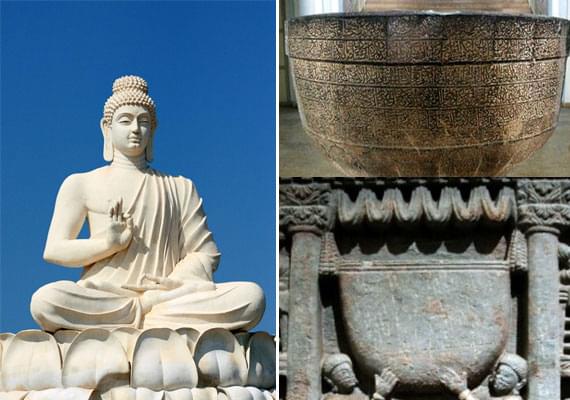More on Indian Minorities
Indian Buddhist Bowl

Buddhists in India are showing a keen interest in a 400-kg greenish-grey granite bowl kept at the National Museum in Kabul. The Archaeological Survey of India (ASI) has claimed evidence to prove that the said bowl was made at a monastery in Vaishali in Bihar in the 6th century BC. Gautama Buddha stayed at the same monastery for about two years before he went to Kushinagar to seek ‘parinirvana’ or salvation. The bowl was taken to Kandahar (then Gandhar) in Afghanistan by the first century AD Kushan emperor Kanishka.
The bowl is world’s one of the most sacred Buddhist relics. It is believed that it was used as a ‘daanpatra’ or alms bowl by Gautama Buddha who visited Vaishali many times and also delivered his last sermon there before his death around 483 BC. ASI sources have confirmed that a swastika symbol is etched on the sixth line of inscriptions on the outer side of the bowl. The Mahayana sect of Buddhism considers the swastika to be auspicious.
ASI sources said the swastika symbol indicated that the bowl did belong to the time of Buddha. The sixth line of the inscriptions which has the swastika is the only original line while the first to fifth lines are superimpositions, according to the ASI. There are also inscriptions in Persian in the Arabic script on the bowl and ASI believes that these were made after the bowl was taken to Afghanistan.
RJD MP from VaishaliRaghuvansh Prasad Singh had raised a demand in Parliament last year to bring the bowl back to its place of origin. Following this, an ASI team was sent to Kabul in May this year to study the bowl and record details regarding its provenance. ASI has also found remnants of white sandstone on the inside of the bowl . While white sandstone is rarely found in Afghanistan, it is found in abundance in the eastern part of India.
Historical records say that Kanishka took the bowl from Vaishali to Purushapura (now Peshawar) after he conquered Magadh around 2nd century AD. The followers of Buddhism hid the bowl in Gandhar when it was taken over by the Little Yuchi under Kitolo in AD 425-450. President Najibullah had ordered the shift of the bowl to the National Museum in Kabul in the late 1980s, during the civil war in Afghanistan.
The fate of the BamiyanBuddhas is known to the world. It is only hoped that the ‘Daanpatra’ will remain safe and maybe one day Buddhists in India can revere it at Vaishali.
